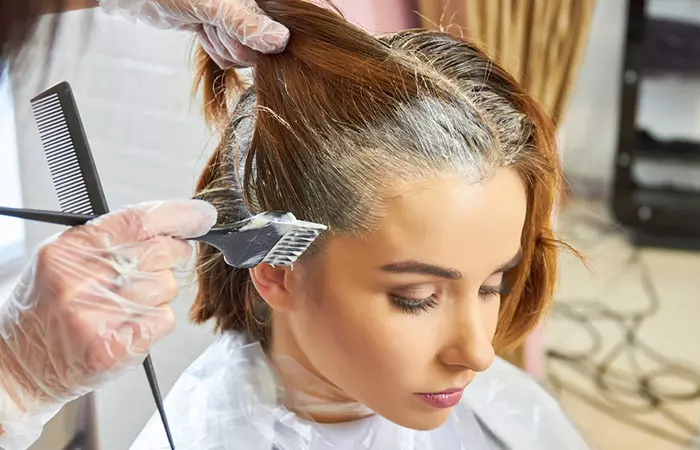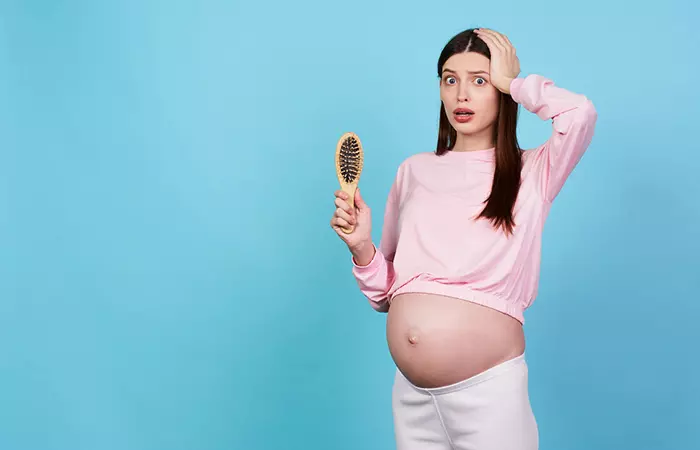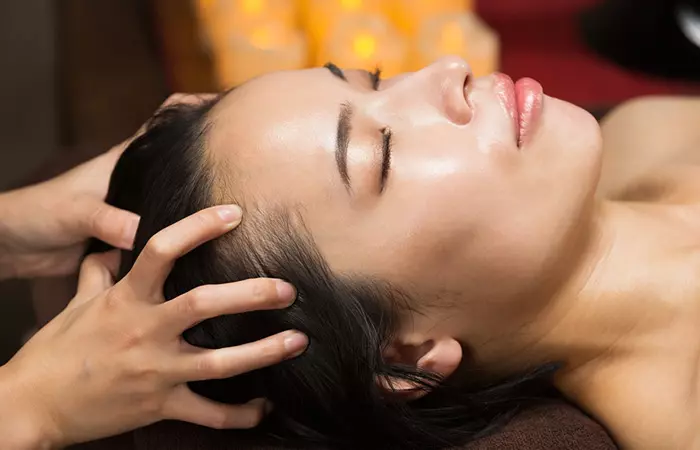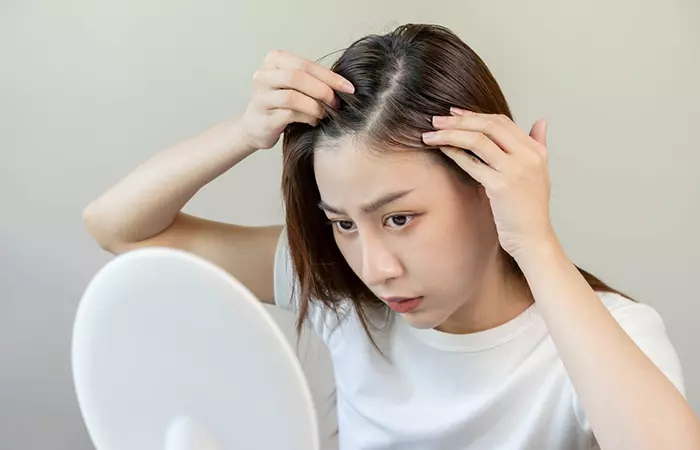Humans lose hair every single day, and new hair grows back at the same time. However, a receding hairline occurs when hair falls out without any new hair growing back. The hairline looks like it is moving backward, towards the crown, from the forehead, back, and sides. The hairline recession begins at the temples and gradually moves backward. It usually forms an “M” shape. Men and women are both affected by receding hairlines (1), (2). There are some cases where people may also experience baldness, mainly at the crown. Although there is no scientific backing, some suggest that age impacts a receding hairline as well. The hair growth cycle consists of three phases – anagen, catagen, and telogen. When the hair falls out during the telogen phase, the growth cycle starts back, beginning with the anagen phase, causing hair to regrow. However, some factors may prevent hair from growing back, causing a receding hairline. Keep reading to understand the causes of a receding hairline and the steps you can take to regrow your hair. If you are experiencing hair loss, consult a dermatologist for proper diagnosis of the underlying condition. They will take an in-depth look at your personal and family history of hair loss. The doctor might also do a few tests to identify the root cause of hair loss.
How To Diagnose A Receding Hairline
Pull Test – The dermatologist pulls your hair to examine how many hairs fall out and how easily they do. Scalp Tissue Biopsy – A biopsy of your scalp tissue may help detect a scalp infection that is causing the hair loss. Blood Test – Doctors also suggest a blood test to determine if you have any underlying condition like thyroid disease that may cause hair loss.
Along with learning how to diagnose a receding hairline, it’s important to look for stages that indicate its onset. Scroll down to know more about it!
Stages Of Receding Hairline
The different stages of receding hairline are as follows: Stage 1: Minimal Receding A slight recession is noticed as the air starts to thin around the temple, forming a subtle “M” shape. Stage 2: Advanced Receding The receding hairline forms a deeper “M” shape causing hair at the edge of the temple to recede and the crown to thin. Stage 3: Widening Of The Bald Area The bald areas at the temple and crown enlarge, and the remaining hair becomes sparser. Stage 4: Extensive Baldness The receding hairline meets the balding crown, leaving a horseshoe-shaped ring of hair around the sides and the back of the head. Now that you’ve learned about the different stages of receding hairlines, scroll down to discover what the experts have to share about this type of hair loss. Keep reading to learn more.
Expert Opinions On Receding Hairlines
Hair experts from all over the world agree that receding hairlines are a fairly common issue. It is a particularly common issue that occurs in older ages. It is influenced by genetics, hormonal changes, and lifestyle factors. Hair experts often recommend early intervention for the best results. This may include topical treatments, like minoxidil, that stimulate hair growth (12). You can also try oral medications such as finasteride to block hormones linked to hair loss. In some cases, platelet-rich plasma (PRP) therapy or hair transplants may be considered for more advanced stages (13). Nutrition also plays a role in receding hairlines. Consuming a balanced diet rich in vitamins like biotin, zinc, and iron can support hair health. Experts emphasize that while receding hairlines can be challenging, there are multiple treatment options to slow down or reverse the process. We learnt the different stages of receding hairline and read some expert opinions. Now, let’s see some ways to prevent or slow it down. You can minimize or slow down its effect in various ways. Scroll down to know more!
Ways To Stop A Receding Hairline
Maintain A Healthy Diet – Just like our body, our hair is also affected by our regular diet. Hence, maintaining a healthy diet helps strengthen the hair and reduce hair breakage. Deficiency of minerals, vitamins (B, C, D, and E), iron, and zinc might lead to hair loss (9). Thus, consume leafy vegetables, nuts, and seeds to maintain hair health.
Medications – Minoxidil and anthralin are common medications to reduce hair fall. A study showed that a 5% topical minoxidil solution could improve hair loss in men (12). The topical application of anthralin controls inflammation of the hair follicles. Hence, anthralin is considered a therapeutic option for severe alopecia areata (14).
David, a blogger, found a solution for hair loss with a specialized dermatologist’s help. He took Finasteride every other day, applied 5% Minoxidil daily, and a multivitamin monthly. He was amazed with the results. He said, “My hair looked stronger and I could see new hair growth in areas where I hadn’t seen any for years (i).”
Hair Transplant – Hair transplant is implanting artificial hair on your scalp to give a fuller appearance to the hairline. In this process, doctors take hair from other parts of the scalp and implant it in the affected area.
Scalp Massage – According to research, regular scalp massage helps enhance blood circulation to the scalp and increases hair thickness (15).
Essential Oils – Rosemary and peppermint essential oils help reduce hair loss and promote healthy hair growth. Researchers have found that the topical application of peppermint oil could enhance hair growth in mice without affecting body weight and food efficiency (16). Rosemary oil can help in the treatment of androgenetic alopecia (17).
Hair Care Tips For A Receding Hairline
Note: Be gentle while you are massaging, combing, or drying your hair. Make sure you do not pull your hair.
Avoid tight hairstyles. Hairstyles that pull your hair can cause severe hair loss, especially at the hairline. Avoid styling your hair in tight braids and ponytails. Let your hair rest naturally, especially during the recovery phase. Wet hair can be stretched 70% more than normal. Thus, drying your hair harshly can weaken it and cause hair breakage. Try scrunching or patting your hair dry. Massage your scalp regularly to help improve blood circulation. This, in turn, enhances hair length and density (14). Use combs as per your hair structure. If you have curly or kinky hair, use a bristle brush as it is not harsh on your curls. For wavy or straight hair, use a wide-toothed comb to remove tangles and knots, and a fine-toothed comb for hair styling. Do not comb wet hair as it tends to be more porous. This can lead to severe hair damage and breakage. If you have curly or kinky hair, you can comb it gently when wet. Avoid hair products with sulfates, silicones, and parabens. These harsh chemicals might cause hair damage and brittleness and form heavy buildup on the scalp. Avoid chemical treatments like hair coloring, straightening, or perming. These treatments can damage and break the hair. Wash your hair at least once every three days to keep the scalp clean. If you have oily hair, wash it every alternate day. Clean hair and scalp help boost hair health. Deep condition your hair once a week to keep it hydrated and nourished. Conditioners contain concentrated, active ingredients that strengthen your hair. Deep conditioning treatments for 5-10 minutes can go a long way in curbing hair loss. If your hair loss is due to nutrient deficiencies, consider taking supplements for them. Consult a doctor to ensure you do not have a supplementary overdose, as some vitamins, if taken in excess, might cause hair loss. Do yoga or exercise regularly to help relieve stress.
When To See A Doctor?
Although hair thinning and hair fall is normal, excessive hair loss may require medical attention. Consult a physician or dermatologist in case of excessive hair loss or patchy spots.
How Long Does A Receding Hairline Take To Grow Back?
It may take up to six months to get visible results from the above tips or over-the-counter treatments. However, every person is different, and hence, the results will also vary according to individual conditions. Genetics, aging, and hormonal changes are some of the common contributing factors to hair loss. Although there are no proven ways to stop your hairline from receding, you can slow down the process. With proper diet and treatments, you might notice a visible reduction in hair shedding. Follow the hair and scalp care tips listed above to prevent a receding hairline and regrow your hair. What are the first signs of a receding hairline? Check out the infographic below to learn more about the same. The first signs of a receding hairline typically include thinning hair near the temples and a gradually higher hairline. Can dietary changes help with hair regrowth? Yes, a nutrient-rich diet, especially one high in vitamins like biotin, zinc, and iron, can support hair regrowth and overall hair health. You should consume these nutrients in the recommended dosage, as too little or too much can cause issues. Can coconut oil regrow one’s hairline? Coconut oil may help improve hair health. However, there is no research to suggest if it regrows one’s hairline. Can you have a receding hairline at 17? Hair loss can start at any age. But for men, it may start in their late teens or early twenties. Does a receding hairline mean high testosterone? No. Anecdotal evidence suggests there is no relation between testosterone and a receding hairline; however, extremely low levels of testosterone may trigger hair loss. Is a buzz cut good for a receding hairline? Yes, a buzz cut is preferable for a receding hairline as it does not pull the hair backwards. What are the best hairstyles or haircuts for people with a receding hairline? It is advised to opt for minimalist hairstyles that are not tight, such as a buzz cut, mohawk, pixie cut, and bob. Learn how to stop a receding hairline with simple tips and tricks. Get the best advice on how to keep your hairline looking healthy and strong by checking out the video below for more information. i. How I Beat Hair Loss and Baldness Spending 12.5 € per Monthhttps://carvalhao.medium.com/how-i-beat-hairloss-and-baldness-spending-12-5-per-month-ee2b28698a82











